



Click on any image to view closer!
Beetle Moses, a Joe of everyday quality like us all, has built a self-described cult following through gag-comics (like the above Big Binky and the Banana Boys: compact one-page web comics built around a central joke). Yet in the confines of a page, Beetle Moses can fit more than humor.
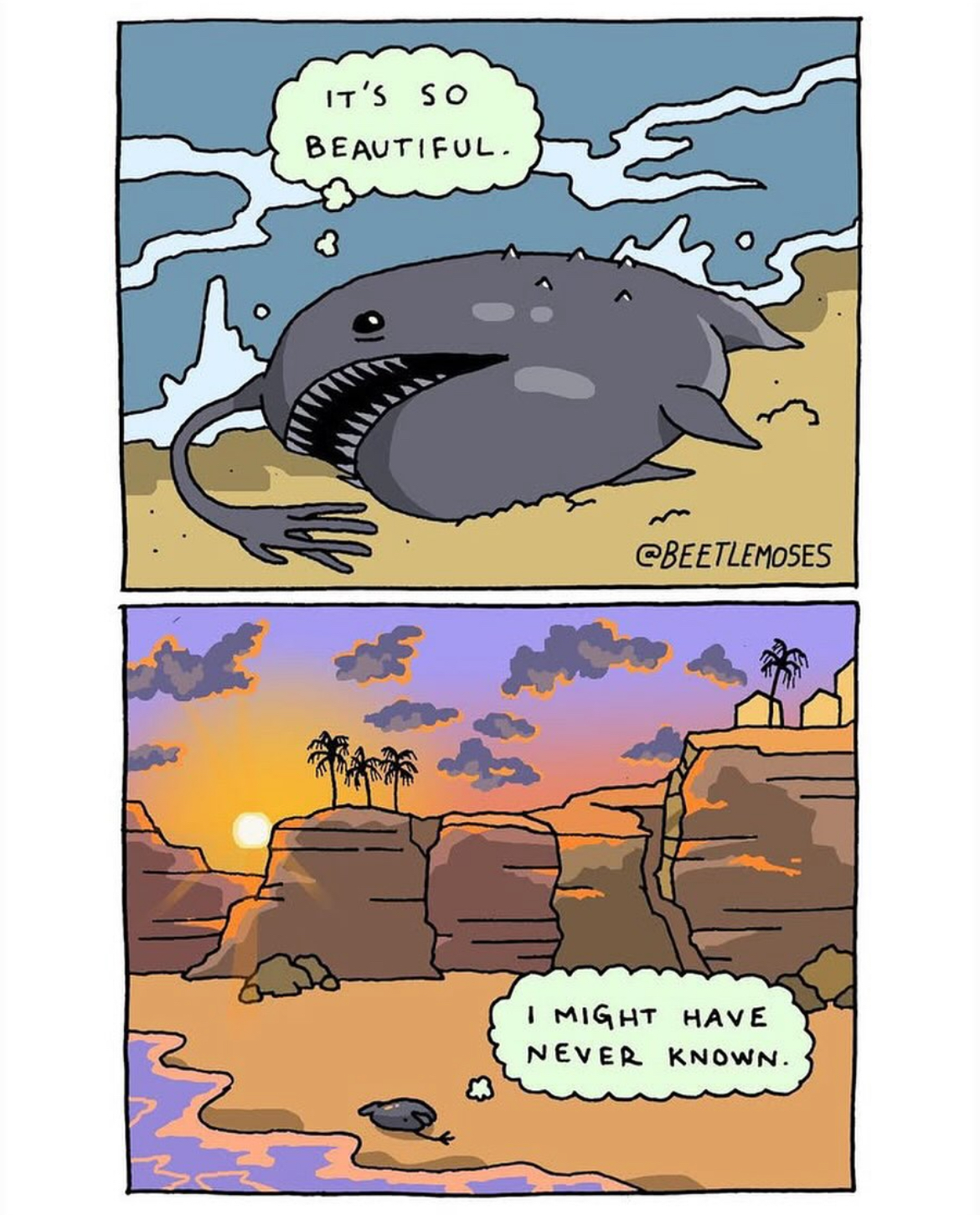
If Binky’s soft, surreal humor marks one end of his range, the dying deep-sea fish experiencing a sunset marks the other. Beetle Moses’ work possesses impressive emotional breadth.
Beetle Moses is a fascinating example of our contemporary. Raising his readership through social media, he’s free to explore content and tone that older, more traditional routes of comic publishing may have felt… uninclined to. While fostered by the internet, he still exists within it, and is unafraid to play off it. At times, he laces our labyrinthian internet culture of references into his work.
From Alex Jones in a gay relationship with a frog to a familiar-looking screaming steak, Beetle Moses exists as a present and reflective force to the ever-fluctuating internet culture, where nonsensical memes or profound thoughts can drift to the surface just as they may in DMs or conversations with friends.
We were excited to sit down with Beetle Moses, to chat about his craft, finding how and where he exists in this tangled, wild, wild web.
Nic: To start things off, why don't you just tell me about yourself?
Beetle Moses: My name's Harris. I go by Beetle Moses online. It's the name of my web comic, but it's also my pen name. I’m a comic artist and illustrator. I've been at it full time for three years. I guess I have what you might call a cult following online.
Nic: What does that shift look like, moving into a full-time, online illustrator?
Beetle Moses: It was pretty abrupt for me. I was working customer service related jobs for 15 years at that point. There was a bit of a catalyst for the whole thing. A friend of mine from college passed away, which was really upsetting and jarring, of course.
Something about that made me put my own situation into perspective. Everything can end in a moment. Not to put it so bluntly, but that is what I was thinking about. Have I done the things that I've always wanted to do? I looked at my life and the answer was no. So I quit my job.
I had some money saved up, luckily at that point. And I was like, I can make a go of this and if I fall flat on my face, I'll just get another fucking job and I'll know that I gave it my best swing.
I was a painter. I had done some comics and like cartooning, but nothing to post online 'cause I was like, people don't want to see this. People want to see more fine art, my paintings, but they don't want to see work like this.
But, from the encouragement of another friend of mine, Yolo Swag Studios, I started posting comics. And that's what really started taking off.
Within a year, I had started selling merchandise. I was starting to flip a little bit of a profit, nothing crazy, it was still tight for a while there. But I realized I could make this happen and I don't know, man. I'm just cuckoo. I couldn't let it go, you know? I still can't let it go. I am constantly wanting to make more.
Nic: So talking about making more, you recently put out a long form comic, The Flyer. From what I saw online, you had some apprehension in putting out a long form piece like that. Talk to me about that process. Shifting your style from mostly short, punchline one pagers to long form, what did that feel like?

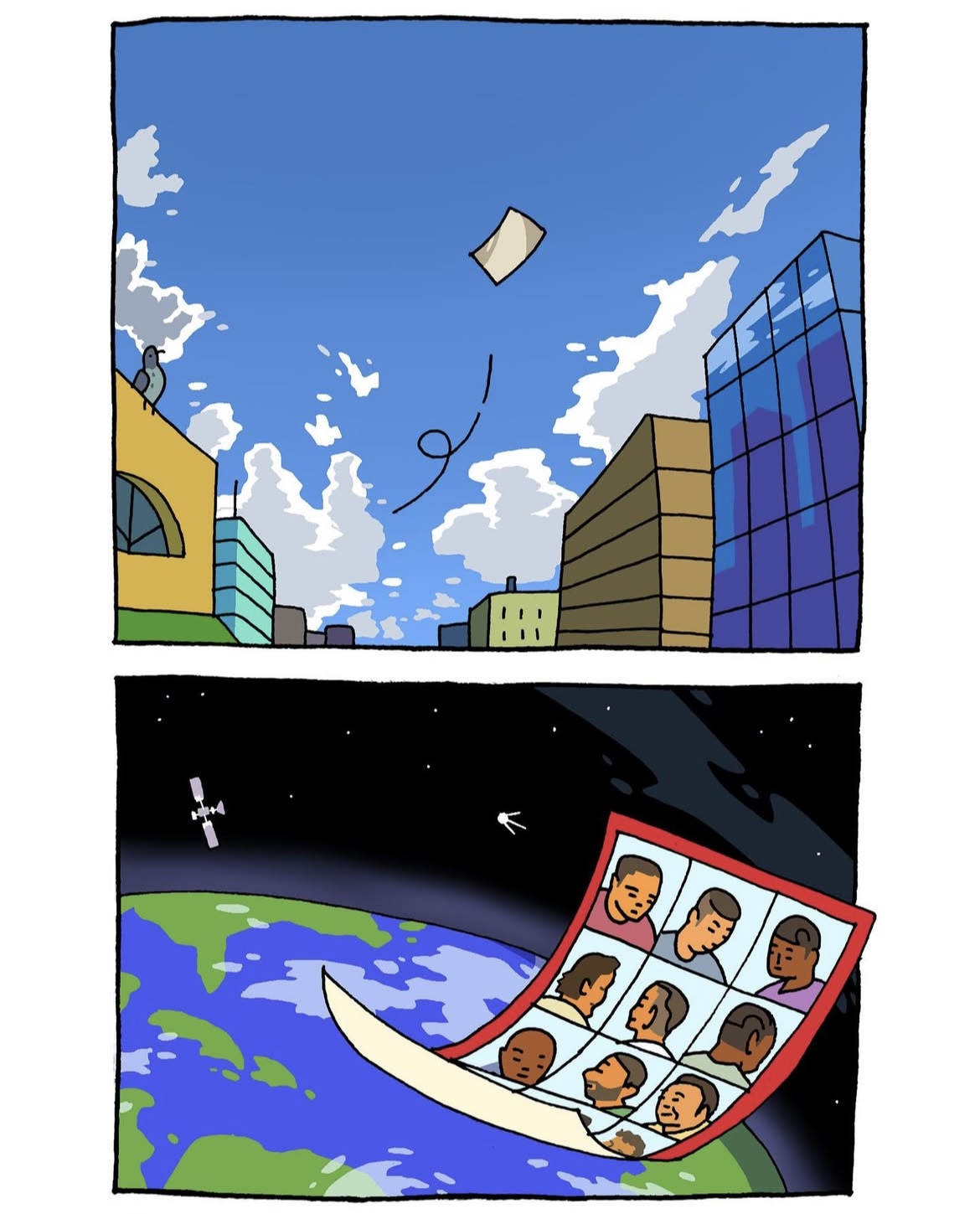
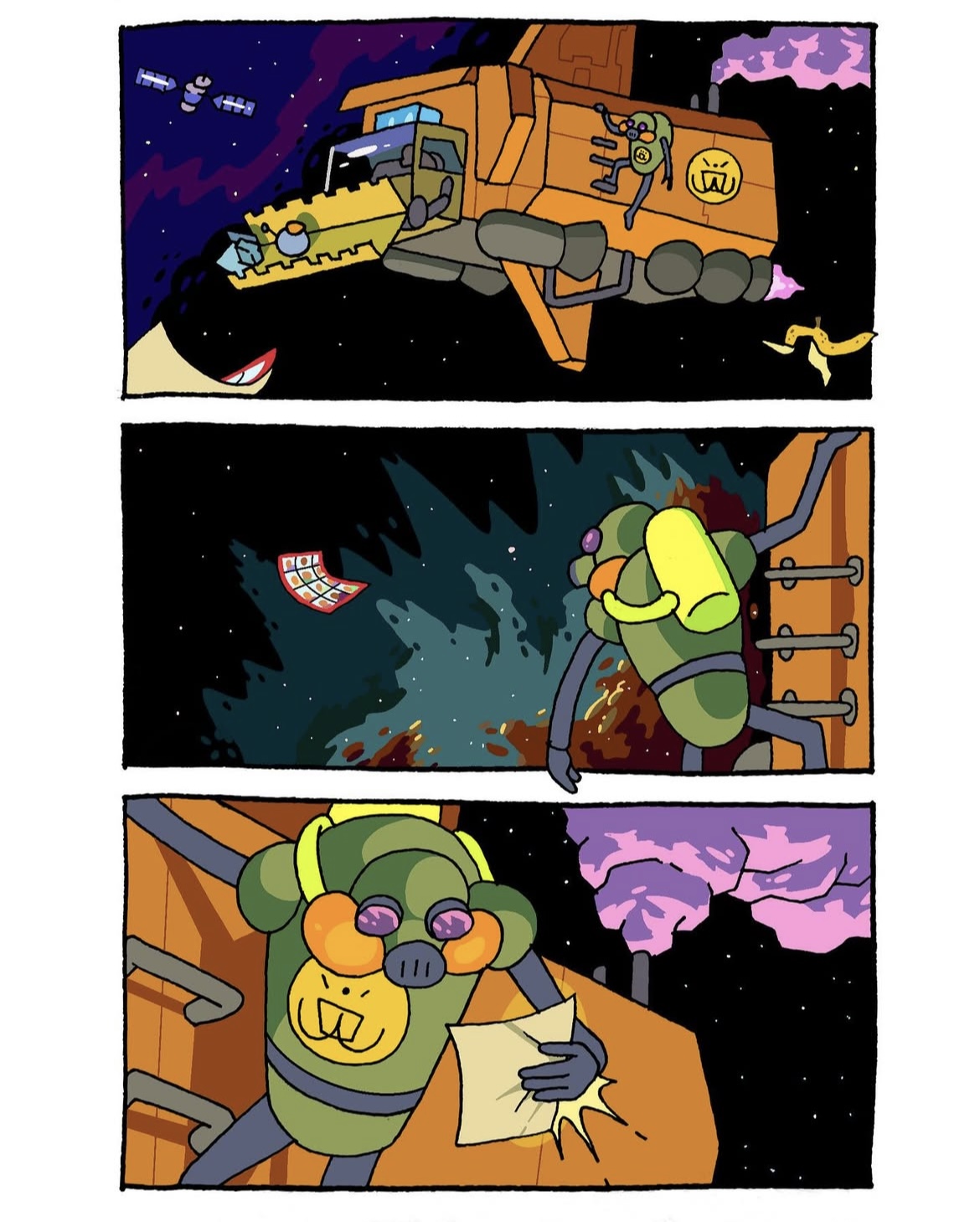
Beetle Moses: I've done some longer storytelling in the past, but now my technical ability has reached a point where I'm able to draw things as they actually look in my head. That has been a really big accomplishment. I still would like to improve more, but I've probably drawn 3000 hours in the last three years, give or take. And that's been huge for me, just having learned a lot. Even if it's not a total success, I feel a better artist for it.
So, I had come up with this idea, which had been sitting in my notes for a while, and I wanted to draw this. The story means something to me. And let me not rush through this. I have no deadline. There's no one asking me to do this. Let me take the idea and make every page look how I want it to look like.
It was a labor of love. There was some stuff that was really repetitive and sometimes tedious, it can be that way when you're really fine-tuning stuff. But I saw this light at the end of the tunnel: I'm going to have this piece behind me.
And I didn't want to paywall it, that was important to me. I didn't want to break it up or be like, follow for the next. I didn't care. I wanted to put the whole thing out, which probably diminished the amount of engagement I would've gotten, but I wanted to tell this story in full. I wanted somebody to read it and say, I cannot believe I just saw this for free.
I was nervous to post it because it is different from my typical gag comics, these two to four panel comics. Gag comics have significantly more reach for an independent artist to get their work in front of people. But the tradeoff is that you have to make it visually engaging right out the gate.
That's a difficult thing to do, and not just visually interesting, but instantaneous. There’s a quickness that you feel like you need to get somebody's attention with. And I was nervous because I worked really hard on the story, but I might put it up there and since somebody has to sit and read it, it's not going to click.
But the most beautiful, amazing thing happened, which is that it was really well received. Everywhere I posted it, it just did numbers, baby.
It was an amazing feeling, surreal. I still don't know if I’ve fully processed it yet. It was a really meaningful moment in my career and life as an artist. I've always wanted to be doing this and the fact that I can make work that I'm proud of and so many people can see all at once. I never, ever take it for granted. I just want to keep doing what I'm doing.
Nic: That's awesome. You've mentioned the virality aspect of your work. How do you feel about the nature of that? Considering also that I'm sure people stumble across your work not on your official account. You want it to go viral, but then it is quickly removed from your umbrella, so to speak.
Beetle Moses: From my perspective, I greatly enjoy when people repost my stuff in other places. I put my name on my work. It sounds a little corny, but it's like a seal of authenticity.
If somebody sees a comic that looks similar to a Beetle Moses comic, there's the difference where they can actually say, this is by him. So, I love when people repost my stuff ‘cause I don't post that many places. And all the social media platforms have become one reserve anyway. If something goes viral on one platform, it's going to get posted somewhere else. So I put my name on it and, in my opinion, it's free advertising.
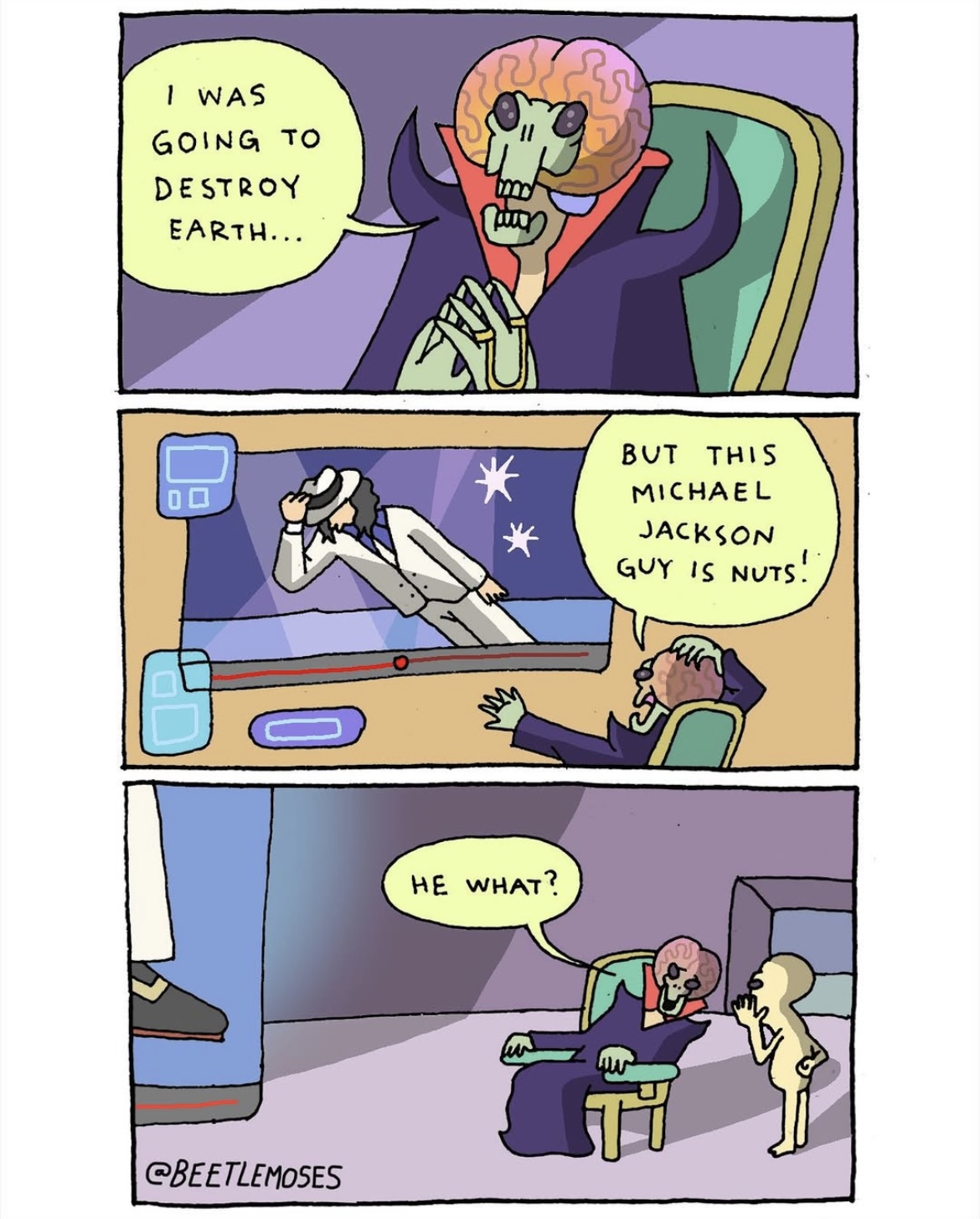
There was a time when I started to see a meme page with a million followers repost something by me and they didn't tag me or credit me or whatever. And I used to be like, what the fuck? Like, this is so many eyes on my work and now no one's going to follow me and I'm not getting anything out of this.
Oh, dude, who cares. Honestly, looking back on that, there's no need to be chasing these random meme pages, which are usually run by a 14-year-old. What am I going to do? Chase these guys around with a rolled up magazine? It's ridiculous, so I actually welcome it.
It's like a little bit of extra validation or proof positive that people want to share my stuff. And a lot of times these days I get people in my comments and they'll be like, ‘oh, I saw your work reposted on some Icelandic message board, and I had to come to your Instagram.’
And I'm like, that's great. The person got internet points over there, no sweat off my back and look, now it's driving some traffic to my page.
Now that's different of course from the, This is Fine Dog, where people reused the art and gained money from it, not crediting or properly licensing the material. That's a totally different story, but stuff like just posting things online, more power to you. God bless. It's crazy out here.
Nic: That's an interesting view on it, no such thing as bad publicity, right? Especially with your water stamp, it can have a good funnel back.
What's the process when you approach a piece of work, whether it's short or long?
Beetle Moses: When it's time to make the donuts, I'll go back into my notes app on my phone and see, ‘okay, I remember I wrote down two ideas right before I was falling asleep last night. What were they? One of them is some chicken scratch garbage. And then the other one I'll be like, that's really funny, but actually I can make it funnier by blah, blah, blah. And then bam, I have the fully fledged idea.
Everything happens on paper first. I draw everything in black and white. Then I have this clunky method of scanning it. I use the camera app on my phone and then I up the contrast. Boom, that's it. Then I color it on my iPad. There's some stuff that I can do on there that I just can't do analog. But I can't do the full comic from start to finish on the iPad. There has to be a physical element.
Along the way, there are little moments happening where I'm like, ‘oh, this is a funny decision. Like what if I put this here? What if I add an Easter egg and stuff like that? I try to up the joke so it's not so plain. And usually that means something in the background or a line being said in a certain way.
Nic: Yeah, that definitely makes sense. You're talking a bit about layering in the joke, right?
As you're working, how does that process look for you? It starts in the notes app and then as you bring it into a visual medium, how does that change your relation to the joke?
Beetle Moses: There's some stuff that changes because specifically with poses and facial expressions. It's a big one. When we hopped on the call, I was working on this one right now:
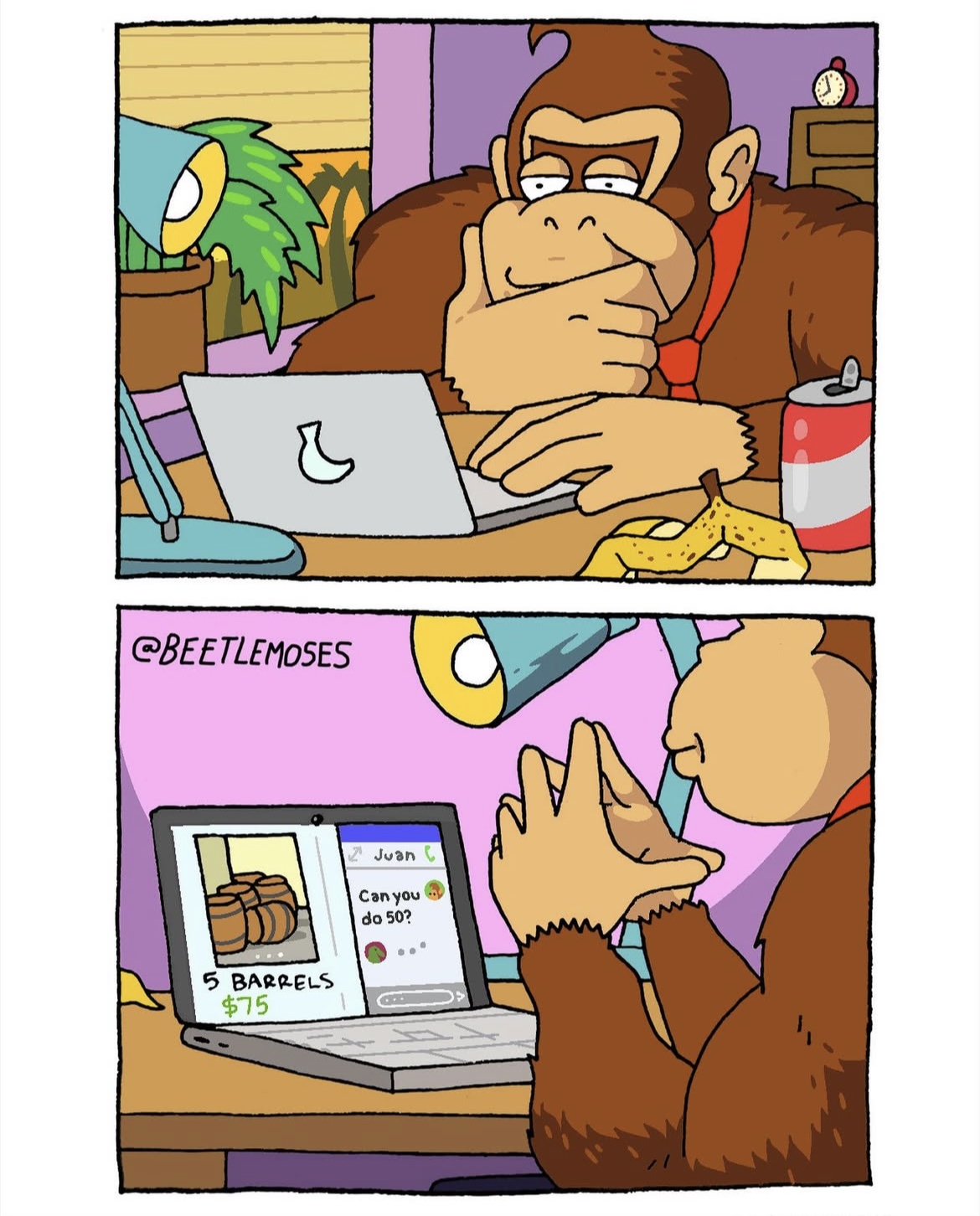
I try to avoid pop culture references as much as I can, but every once in a while I'll have an idea that is a pop culture reference, but it does make me laugh, so I'll do it.
To elevate the joke or add a layer of, I don't know, irony or realism: the poses need to be right and the facial expression needs to be right. With the Donkey Kong one, I had to take poses of myself, like hawing and humming in front of a computer, making pensive faces. That elevates the joke, rather than just having DK in front of a computer, there’s this sort of sarcasm. That’s where the layers of the joke come in for me.
Sometimes I can find that on Google images, which is a funny situation. Recently, I drew something with an emo gorilla.
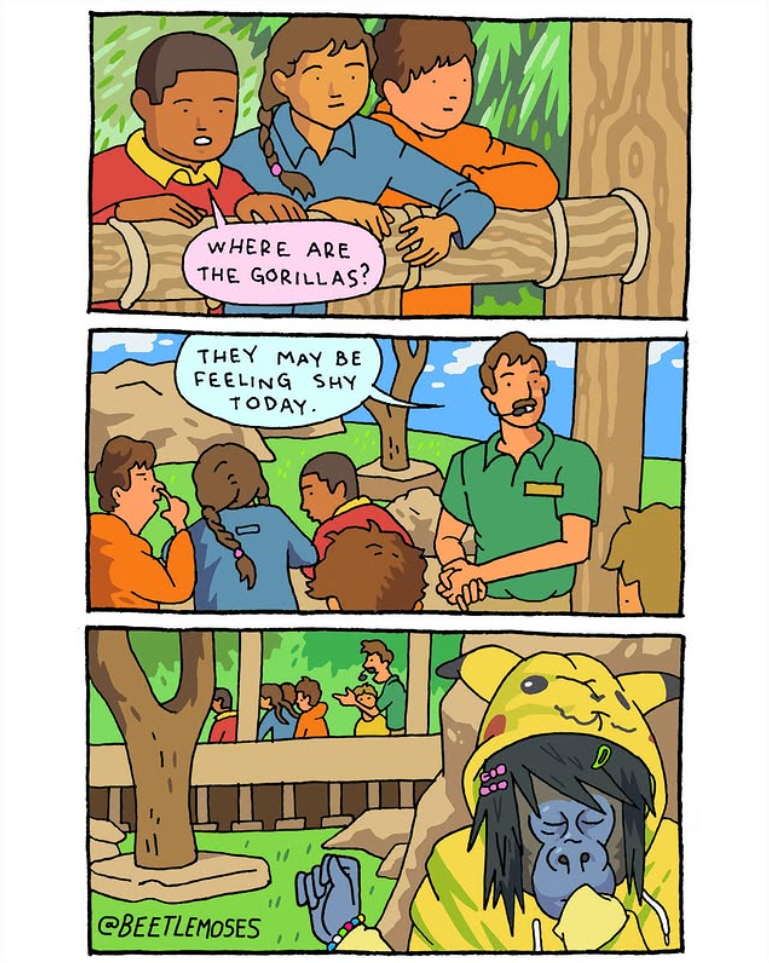
I knew that I needed to elevate the joke. I didn't have it in my head when I came up with the idea, that I wanted the gorilla to be wearing this type of hoodie and in this position, I needed to look up like, ‘scene kid in hoodie.’ I found the type of vibe that I was looking for, and then I referenced this image.

There’s a level that I just can’t come up with in my brain, I have to mimic it, but somebody recognized that I had used this Google image. It was a picture of them. I didn't know who they were. They just showed up there and they were like, ‘Oh my God. I think Beetle Moses used this image of me as a reference.’
It's that sort of, I don't know what it is, iconography or something where people can associate, like this is an emo or scene character.
Nic: That attention to detail definitely shows.
You're touching on something that's interesting in the, I don't know what you want to call it, but the massive internet culture, the kind of iconography you're using. Because recently you had this comic with The Ring girl crawling out of the TV.
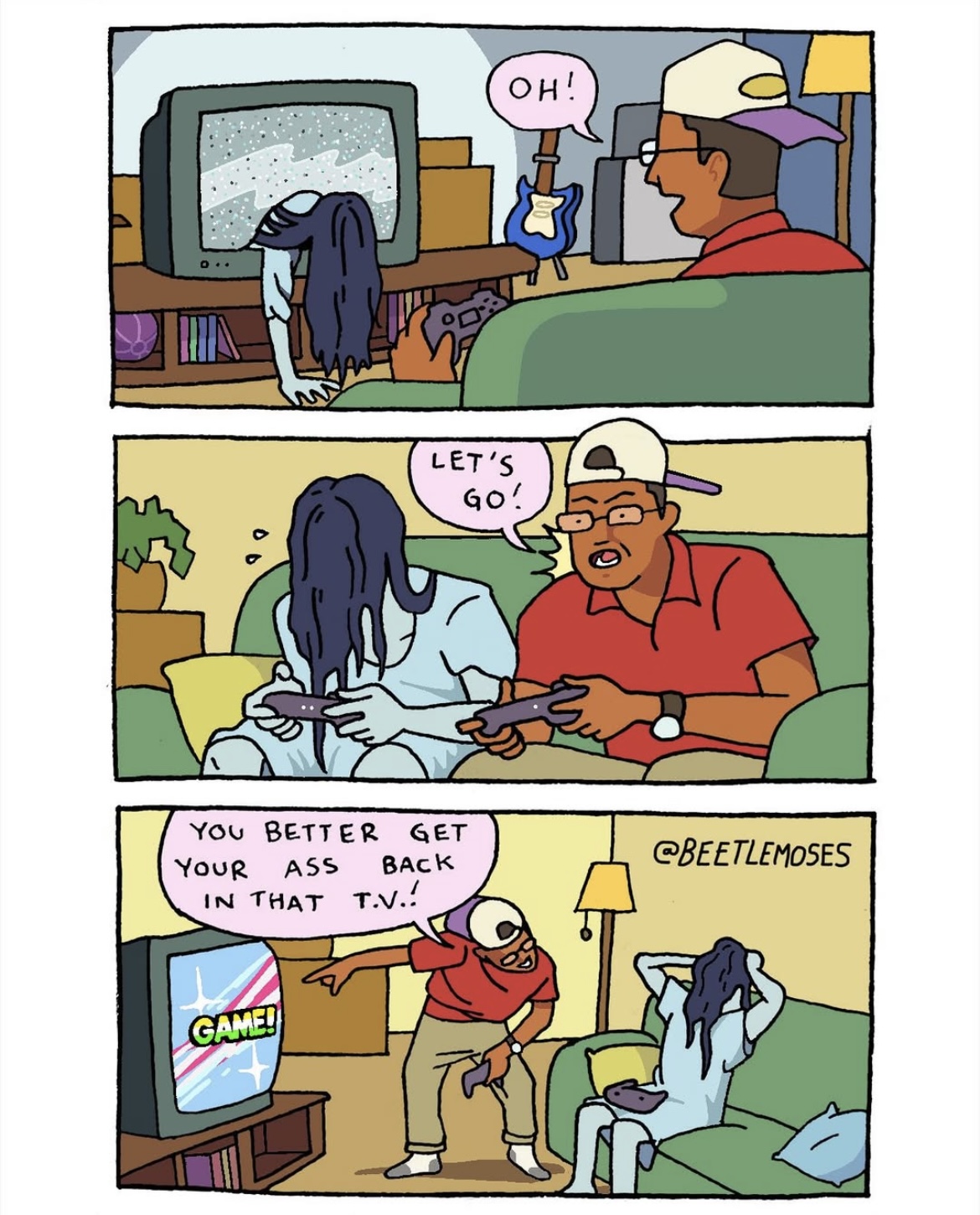
Before even going to the comments, the GAME on the screen, I'm like, ‘oh, Smash Bros.’ That put me back to so many friend's houses, just yelling and gaming. There's something funny there, how the power of the image can really bring so much more.
Beetle Moses: That’s sort of where I am giving myself a pass with some of the pop culture references: if it puts the person in a place. Sometimes you need that because we are surrounded by pop culture. All the time there's things going on and things that are in the zeitgeist that people are going to pull from and recognize.
I don't think the joke is leaning on it, but I do think it elevates the joke. I could have probably just put KO and it would've basically been the same joke. But adding the GAME from Super Smash, I knew that many people were going to see that and be like, ‘I was in that situation, I was at my friend's place playing Smash Bros talking shit.’ That’s what I'm going for and I'm glad that you were able to pull from that too. I liked the way that comic came out.
Nic: Not only pop culture, you're pulling on a lot there. Okay, here's a generational video game that a certain demographic's going to get, and then here's also an iconic horror movie scene.
As you're crossing these genres, or whatever you want to call them, how do you approach your engagement with the absurd or the surreal?
Beetle Moses: That's really where I've been leaning more recently. Big Binky and the Banana Boys I think is a perfect example, right?
At a glance, I don't think that somebody would read it and be like, this is so surreal. But it is an atypically structured joke and comic, which is kind of what I'm going for at this point.
So sometimes I have to catch myself to not look disdainfully on some of my work from even a couple years ago. I have to remind myself that I cut my teeth with this stuff and it's still good, but I am always trying to look forward. And the reason it ties into the question you asked is that’s where I'm trying to lean into now. That type of humor, which I really like and somewhat sets my comics apart, is the absurd, the atypical joke structures, the surreal.
Web comics are so digestible and so instant, a lot of people think that they're basically memes. I love the challenge of trying to cram something that is more heady or more weird or forces the reader to be like, wait, what? The fact that I can cram emotion into a bite size piece that can have that type of reach; that is what I'm going for.
I don't know what the end game of that is yet, 'cause I'm in the midst of it. I don't even know that it's going to be a huge success for me. But it's what I'm enjoying doing right now and I'm trying to make it only weirder. I'm only trying to get weirder.
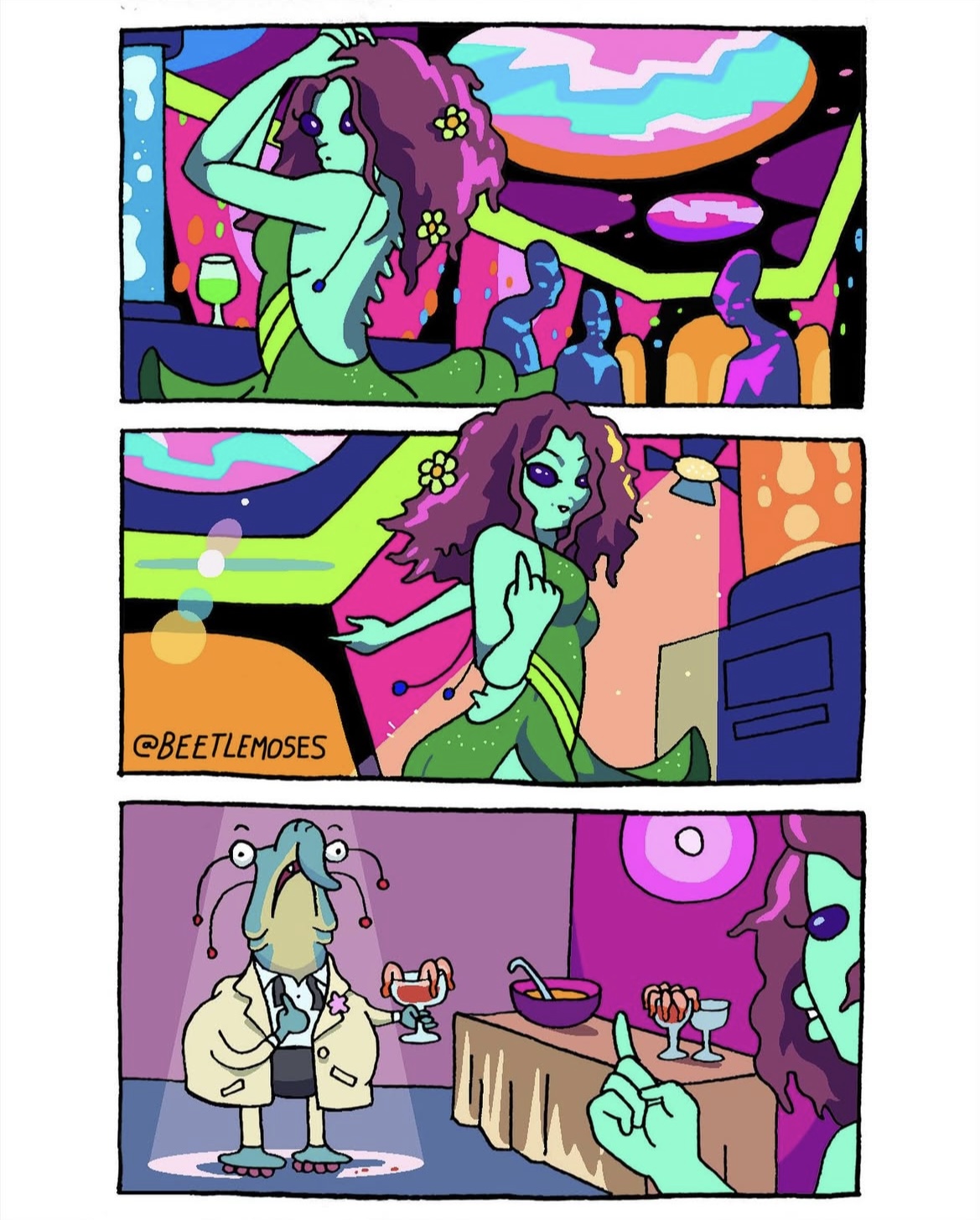
Nic: Hell yeah. Rounding out, this is a question we ask everyone. It’s important to us. Why do you make art?
Beetle Moses: I don't know what the hell else I would do. I don't. I suck at having a regular job. I never got a promotion at a job because I just couldn't pretend to care. And I don't want to be a bum, you know? I don't want to do nothing.
I feel better when I'm productive. And even though I am making just silly, goofy stuff, a lot of it is stupid — I've made jokes about the Joker and balls and stuff like that. But I do think that I am at my best when I'm being silly, drawing, making art, and sharing it with people. I can't see myself doing anything else that would be a more worthwhile use of my time, to be honest.
This is me at my best self and it's up to the reader to decide if they think it's amazing or not.